Five key stages in the 2024 Giro d'Italia
Analysis of where the race could be won and lost in 2024
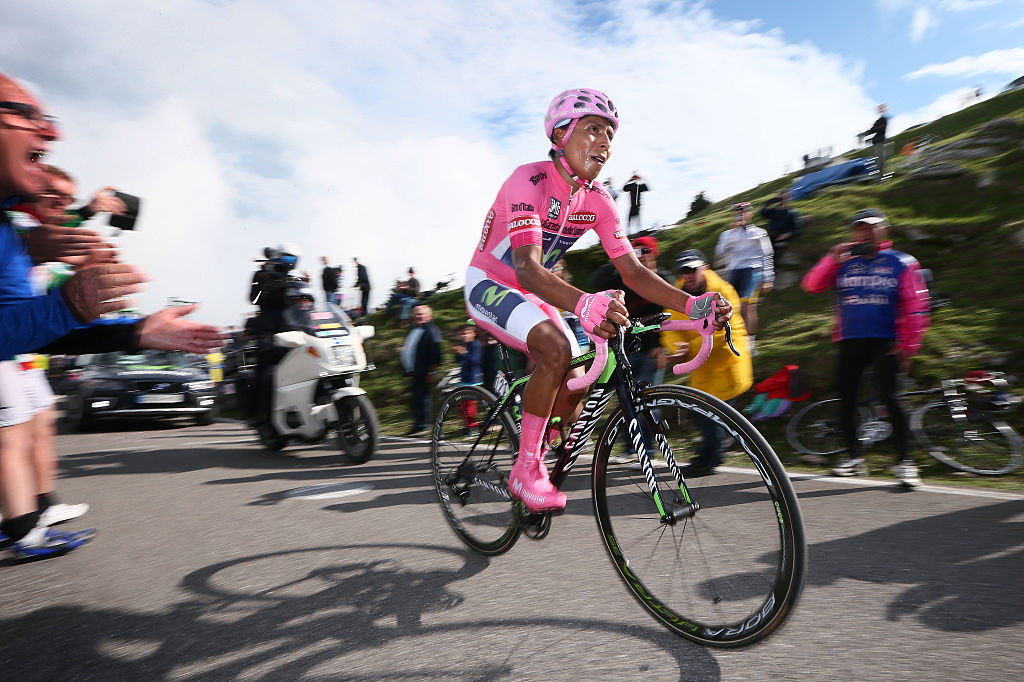
The 2024 Giro d’Italia route can be explained in a few numbers: 21 stages, 3,321 kilometres of racing, 68.2km of time trialling, six summit finishes and seven mountainous stages, all between Saturday, May 4 and Sunday, May 26.
Yet the route of the 107th edition of the Corsa Rosa also forms the geographical tapestry on which three weeks of deep dives into the history of cycling’s second biggest stage race and fresh, mostly exciting chapters of the race simultaneously combine.
Some parts of the 2024 route are wholly unprecedented, too, others are steeped in Giro d’Italia tradition. The former are sure to provide an extra, intriguing dimension or perspective next May, the latter will see another layer added to the drama and spectacle that has unfolded on the same roads in previous years, in some cases, all the way back to the first-ever Giro d’Italia of 1909.
Overall it's fair to say the 2024 route, which was presented in the city of Trento on Friday, October 13, is finely balanced and perhaps not as mountainous as in some previous editions.
Either way, the lengthy pair of time trials matched by some steep mountain-top finishes and daunting stages through the Alps, Apennines and Dolomites, culminating in the final double ascent and descent of the Monte Grappa.
Here we delve into five stages that look set to shape the 2024 Giro d’Italia.
Stage 2
Sunday, May 5: San Francesco al Campo - Oropa 150 kilometres
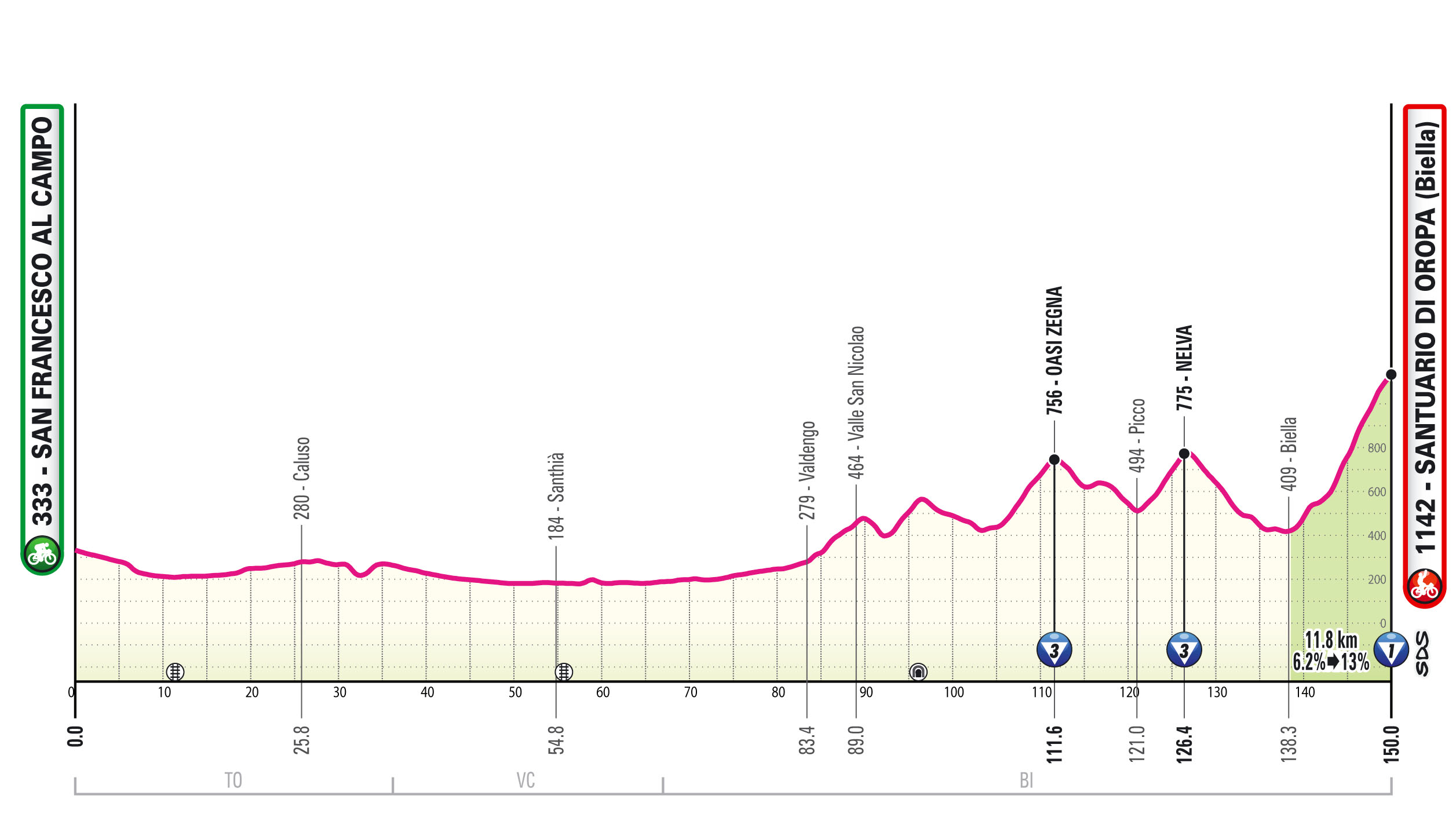
The first big climbing test. Given its position in the 2024 race, Oropa will both act as a real wake-up call for the current peloton, whilst simultaneously constituting a major blast from the past. For one thing, the last time a major mountain-top finish featured in the Giro d’Italia’s opening weekend was in 1989, when Portugal’s Acacio da Silva took the last of his five stage wins in the Corsa Rosa on the slopes of Mount Etna.
Get The Leadout Newsletter
The latest race content, interviews, features, reviews and expert buying guides, direct to your inbox!
Nestled in the Alpine foothills, the sanctuary of Oropa could hardly be further from Sicily and the scene of Da Silva’s success, but as the last climb on stage 2, and the only major ascent of the day, it’s sure to play an equally big outcome. There will have been skirmishing on stage 1’s rolling course through Turin on the opening Saturday. But any team whose GC leader is in good shape will want to hit the ground running on Oropa and push any rivals who might be a little on edge off the board completely - before they get a chance to regain momentum.
After commemorating the Superga air disaster in the Turin stage, during the approach to Oropa, expect lots of TV replays of Marco Pantani’s 1999 Giro d’Italia victory on that climb as the stage heads from the Francone velodrome in San Francesco al Campo, close to Turin airport, and heads north for the race's first key climbing showdown.
Widely rated as one of Pantani's greatest climbing performances - although it has to be taken in the context of his positive hematocrit test a week later - the opening instalment of the day’s drama saw Pantani fighting to unblock his chain on the side of the road. He then returned to the main bunch after a furious chase courtesy of his team, chased down all his rivals and passed them all, going on to win the stage alone. One Pirata urban legend insists that he overtook no less than 49 riders.
True or not, by the summit Pantani was still not certain that he had won and crossed the line without raising his arms. He only later discovered that he had set the course record for the climb: 17 minutes and 7 seconds, a record which still stands today.
The climb is not overly steep, although 12.4 kilometres long is a respectable distance in anyone’s book. Averaging 6.2%, the toughest segments come with around 7km and 3km to go, where it briefly rises to just over 13% and 11%.
But that isn’t enough to get the climbers going - and with a long time trial also coming in the first week at Perugia on stage 7, they know they have to make the most of chances like these - the ramp of around 9.6% at the start of the final kilometre looks like another great opportunity.
All in all, Tom Dumoulin might be the most recent winner on Oropa in 2017 en route to overall victory, but for the tifosi, Pantani and what was dubbed la rimonta del secolo, ‘the comeback of the century', is the only ascent of Oropa that really matters. Whatever happens in 2024, it probably won't change their minds about that, but it'll likely still have a major impact on the Giro.
Stage 7
Friday, May 10: Foligno - Perugia (individual time trial) 37.2 kilometres
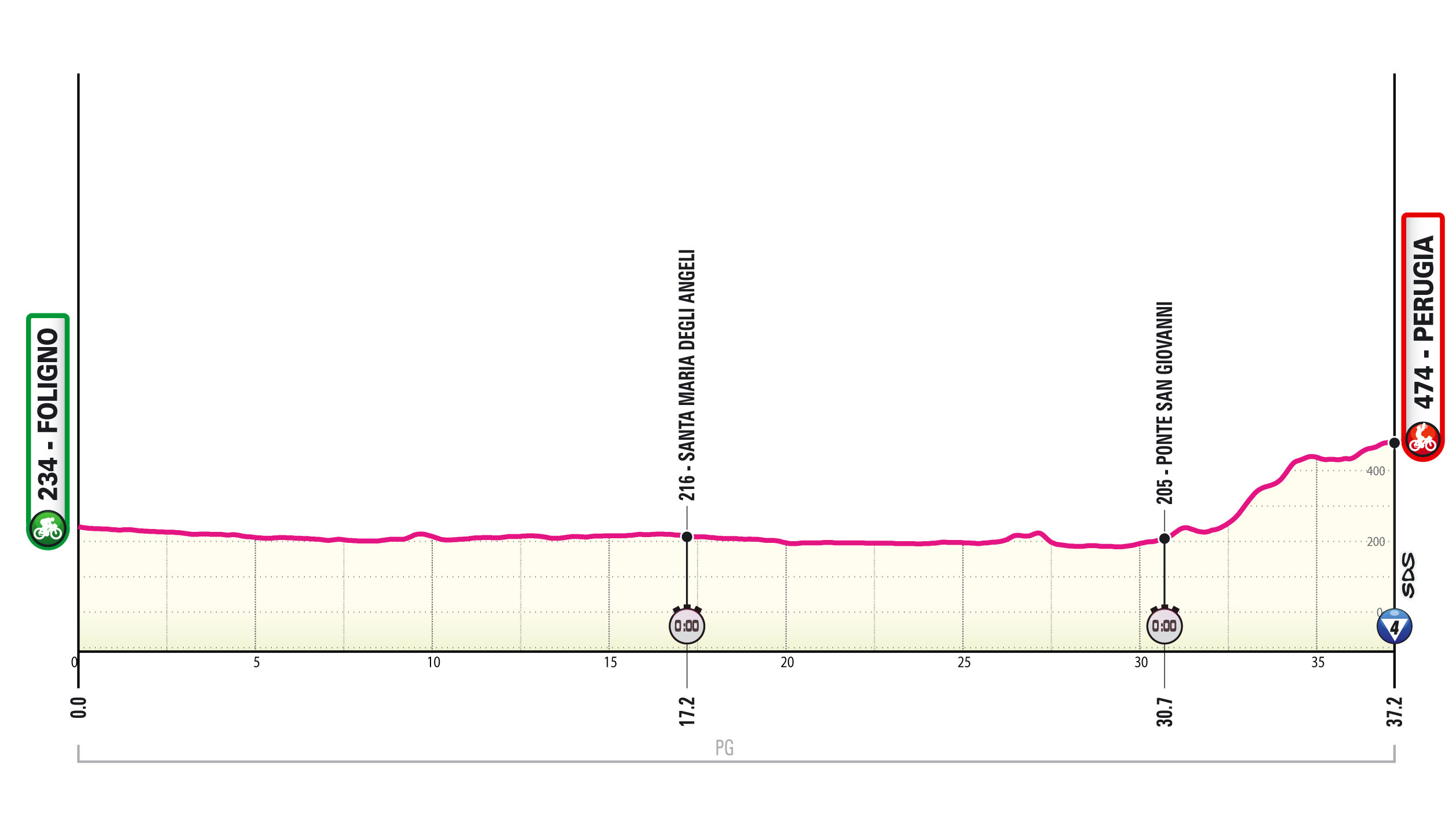
A lengthy and complicated time trial ends with an uphill finish that should establish some major differences between the top favourites. If Oropa likely showed us who could lose the Giro, this stage - particularly if you combine the result here with the second major time trialling challenge on stage 14 - will surely show us who is in the running to win it.
Combined with the 31 kilometres on the stage 14 ITT, there will be just under 70 kilometres of time trialling in total in next year's Giro: that's only two less than last year, and could create anything up to three minutes advantage for any TT specialists battling for the GC. Given how little margin the climbs created between the favourites in the 2023 Giro, barring the final uphill time trial, then in 2024, that kind of time gap could be even more important.
What makes the opening Giro ITT much more significant than its counterpart a week later is that apart from being slightly longer than stage 14, stage 7 also has an uphill finish. It's just a category 4 climb, but at the end of such a fast, first segment of time trialling, that could be enough to make it considerably trickier to calculate efforts. Witness the 2023 Giro's opening TT in Ortona, mainly flat but with its final ascent to the hilltop town, and which globally overall winner Primož Roglič had no doubt in describing as a GC day. In a time trial that's nearly double the distance of the 19.6km Ortona TT, much more so.
Tour de France's director Christian Prudhomme made no secret of that race’s time trial at Nice being an open invitation for the World TT Champion Remco Evenepoel to participate. But after seeing the 2024 Giro route, a few more specialists may well think of heading south in May for another Grand Tour.
Stage 15
Sunday, May 19: Manerba del Garda - Livigno (Mottolino) 220 kilometres
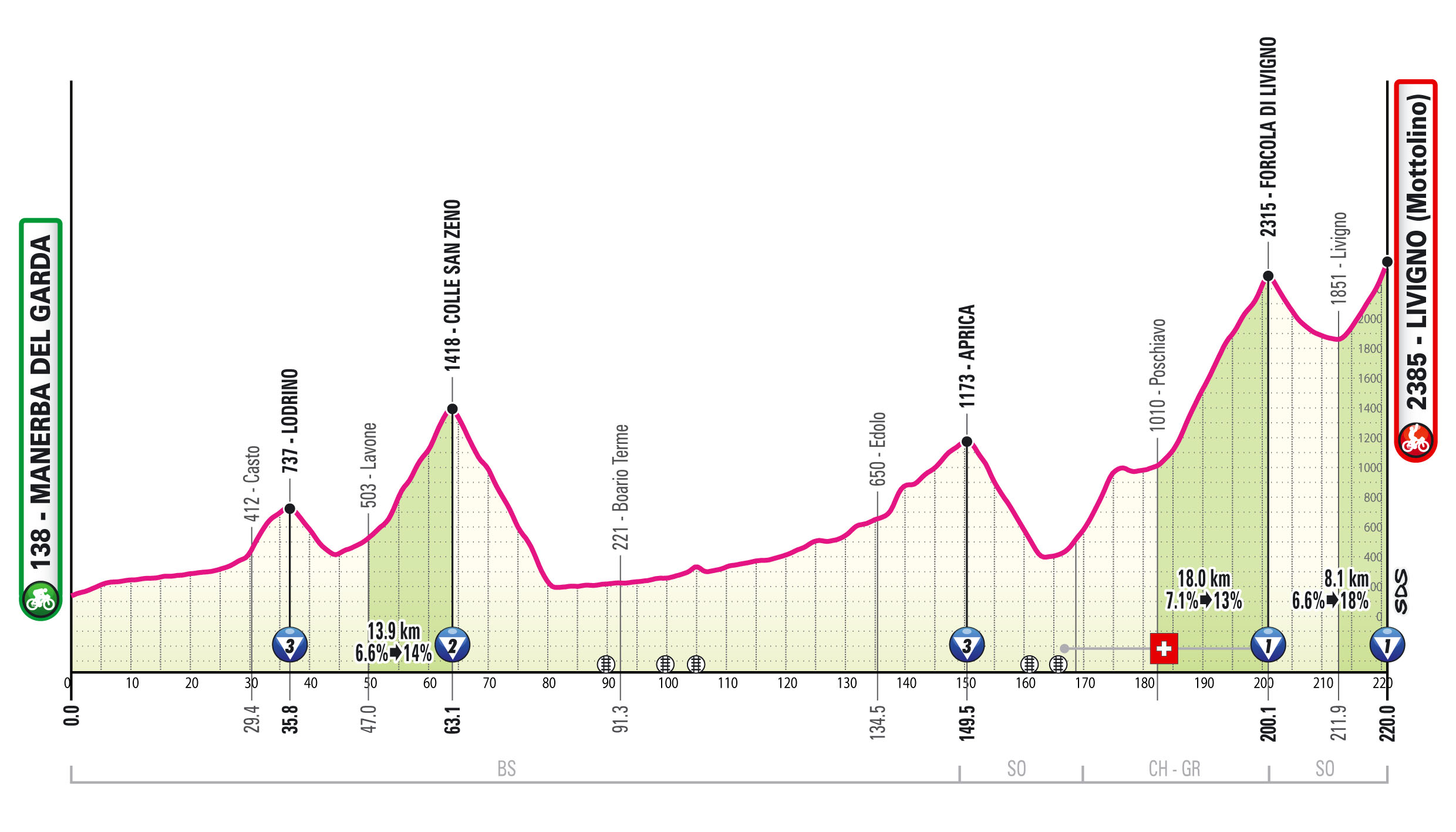
By this point in the race, the 2024 Giro d’Italia will have had a lengthy, but steady grind to Prato di Tivo on stage 8, and an even longer - 20 kilometres! - drag up to Bocca della Selva on stage 10. However, the Giro’s second half is invariably its hardest and Sunday’s ascent to Livigno, just over the border from Switzerland, is the full-scale introduction to the race’s usual brutal assault on the Alps and Dolomites.
Finishing well above 2,000 metres and a whopping 220 kilometres long - two more big factors that may catch out the under-prepared - the first 150km of stage 15 bring the race to the foot of the Alps and are rugged but in no way overly challenging. What is really going to hurt are the two category 1 climbs in quick succession that conclude the stage.
The first, the 18-kilometre Forcola di Livigno, takes the riders on the race’s sole foreign incursion of 2024 into Switzerland. The smoother, usually well-surfaced roads which predominate in the Swiss Alps - far more so than in Italy - will probably help compensate in part for the climbing effort and gradients, which barring one short 18% ramp, rarely go higher than 8%.
After the Forcolino, though, the fast descent back into Italy and last climb of Mottolino are perhaps where the Giro will experience its first major sort out. Much shorter than the previous ascent, but with some notably steeper ramps with gradients reaching well into the double digits and a possible off-road segment in the final two kilometres as well, this is exactly the kind of challenge that could put any rider already struggling on the interminable Forcola beforehand definitivel into the red
Another key factor to bear in mind is the weather, given this is the first stage of the 2024 Giro that ventures into the main Alpine ranges. Snowfalls could, therefore, most likely cause some last-minutes alterations of the route or even a cancellation. Last year’s Giro was one of the wettest and coldest of recent years, one Alpine stage was severely truncated as a result, and question marks of varying size over the wisdom of continuing in such poor conditions hovered over much of the last two thirds of the route. Fingers crossed that doesn’t happen again.
Stage 16
Tuesday, May 21: Livigno - Santa Cristina-Val Gardena 202 kilometres
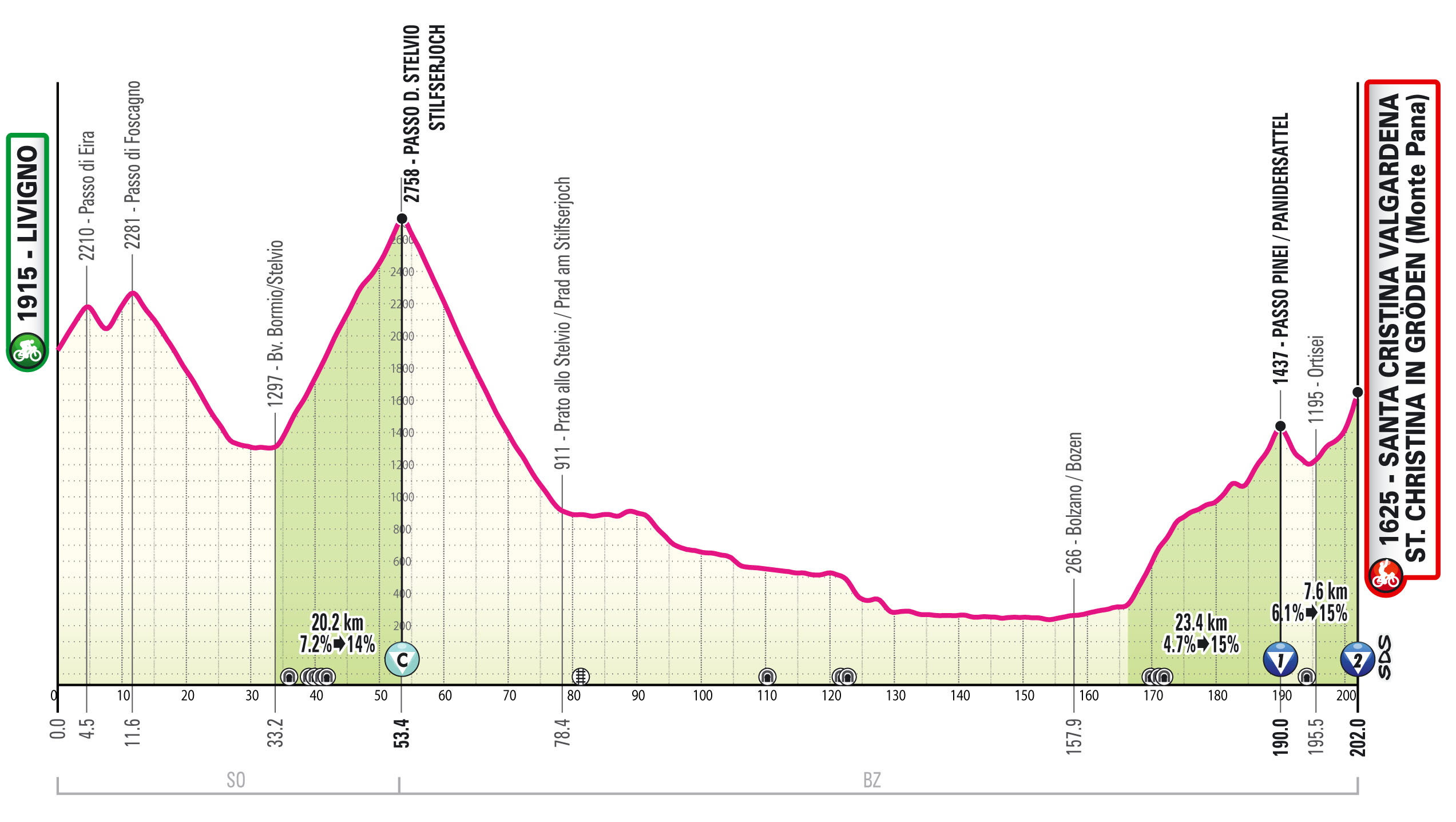
Some fans might argue that the Stelvio, the Cima Coppi of this year’s Giro d’Italia and one of Italy’s most beloved climbs, comes far too early in this stage. But for all the Stelvio's infamous but stunning series of hairpin bends could end up being a little overshadowed by the toughness of the finale and the long, flatter approach to the last two ascents of the day, this could yet be one of the most memorable stages of the 2024 Giro d’Italia.
That's because it ends with a classic Giro double-whammy of a much harder ascent followed by a short, punchy rise to the finish, in this case the second-category climb to Santa Cristina, and which plunges us down the Giro's memory lane with a vengeance.
Just as Oropa on stage 2 marked one key Pantani anniversary from 1999, close to the end of the main period when the Italian climber was a dominating figure in world cycling, the finish in the small town in the Val Gardena valley marks the 30th anniversary of another moment of Pantani glory, coming right from the start of his career.
1994 was the year when Pantani burst onto the scene by defeating no less a figure than Miguel Indurain, first testing him to the limit on the Mortirolo, then dropping the Spaniard for good on the Santa Cristina. The winner of the Giro in 1992 and 1993, Indurain continued to rule the roost in the Tour, but after Pantani’s triumph, he never returned to the Italian Grand Tour.
Stage 16 of the 2024 Giro does not tackle the Mortirolo, but the 23-kilometre Passo Pinei that precedes Santa Cristina is long and challenging enough to start the process of dislodging any of the favourites who are in trouble. Then Santa Cristina could finish them off for good, just like Indurain 30 years ago.
It’s also worth pointing out that this ultra-difficult stage will be preceded by a rest day, which always sees some riders fail to handle the sudden dip in pace and suffer the following stage. Given the early presence of the Stelvio, for all it will likely be tackled at a relatively stately pace given both the remaining distance and its inherent difficulty, if anybody is feeling out of sorts, it will likely prove a major and most unwelcome challenge. That's especially the case when there are still nearly 150 kilometres left to race, not to mention two major climbs.
Stage 20
Saturday, May 25: Alpago - Bassano del Grappa 175 kilometres
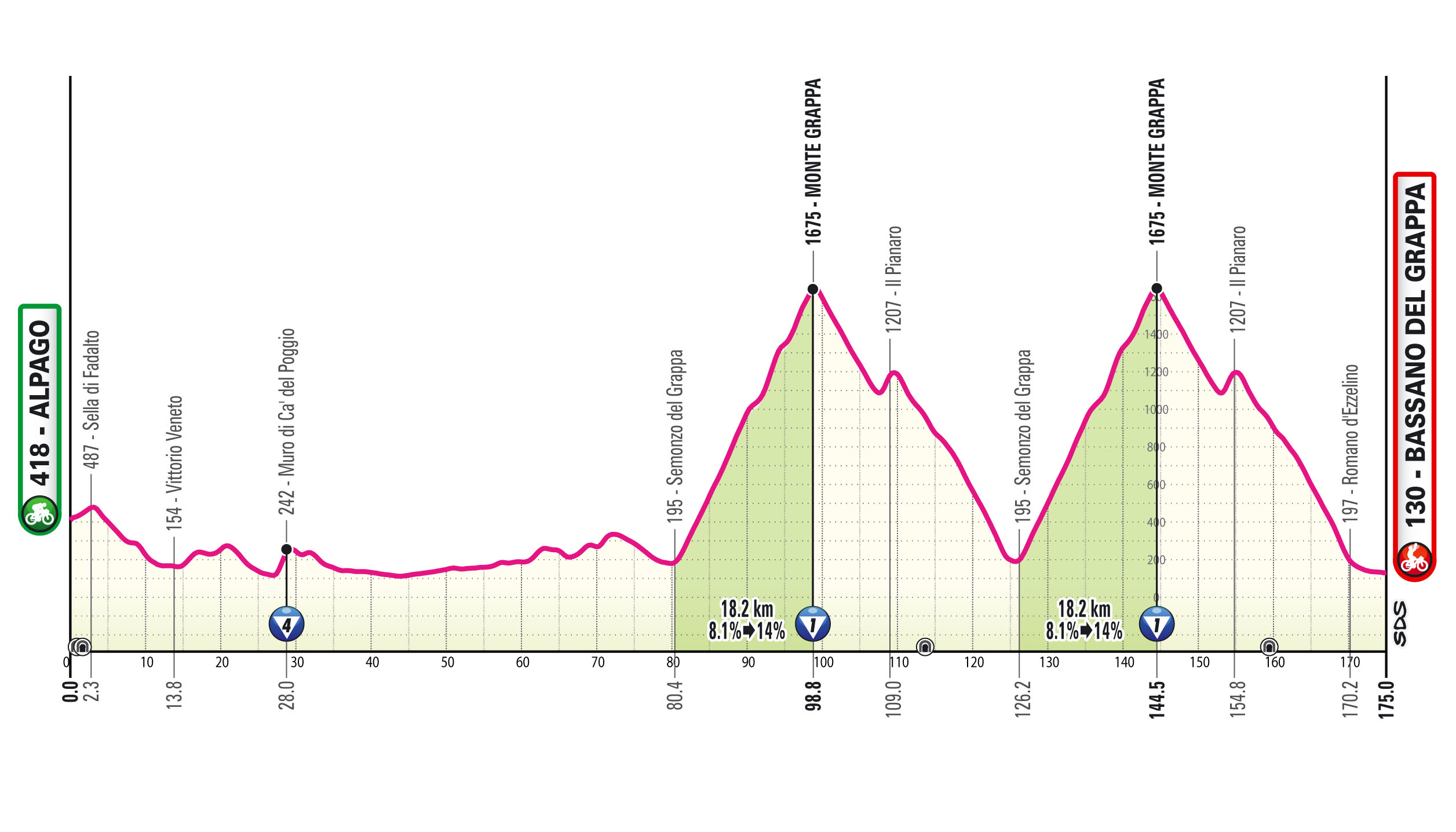
The final mountain stage of the 2024 Giro d’Italia is a seriously tough one, with a double ascent and drop down from the ultra-difficult Monte Grappa to provide the last word on the GC. At 175 kilometres in length, at this point in the race it’s the kind of distance that will wear down all but the most resilient, making for a resounding climbing finale to the Giro, particularly if the weather is tough.
Intriguingly for a classic high mountain trek, stage 20 is not all about interminably long, grinding ascents or gentler foothill climbs, either. The short, early ‘wall’ climb of the Muro di Ca’ del Poggio, tackled in the first 60 kilometres, is unlikely to see any major GC attacks - but with gradients of up to 12%, it’ll definitely reveal which of the overall favourites could be on a bad day.
The piece de resistance though, is definitely the Monte Grappa - 18.4 kilometres long at 8.4%, but ramping up to a steady 9.4% for the last few kilometres, including a tricky double descent to Bassano del Grappa to finish off. The climb itself was last used in the 2014 Giro, where Nairo Quintana confirmed his stranglehold on GC with a stunning time trial victory. This time round, such is the speed of the descent, likely whoever is ahead at the top will still be in front at the finish.
A word about Bassano del Grappa. Although better known for Giro stage starts than finishes, in 1946 the Italian town was the scene of one of Fausto Coppi’s Pyrrhic mountain victories, where he was able to drop Gino Bartali, but unable to gain enough on his archrival for the overall win. Then in 1974, Bassano del Grappa was witness to one of Eddy Merckx’s greatest-ever victories through the Dolomites, 24 hours before he claimed the overall triumph in the Giro that year.
As the race returns the climb 40 years on in one final anniversary celebration, every GC contender will be dreaming of doing the same.
Alasdair Fotheringham has been reporting on cycling since 1991. He has covered every Tour de France since 1992 bar one, as well as numerous other bike races of all shapes and sizes, ranging from the Olympic Games in 2008 to the now sadly defunct Subida a Urkiola hill climb in Spain. As well as working for Cyclingnews, he has also written for The Independent, The Guardian, ProCycling, The Express and Reuters.
